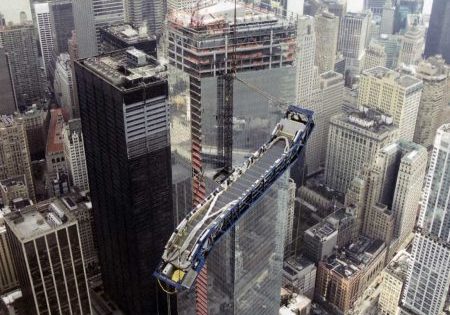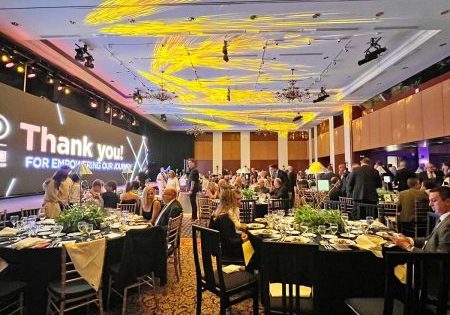Looking at NEII’s merry past and unwrapping its bright future as the 100-year-old elevator association does its part to provide peace on earth.
A Christmas Carol, the classic tale from Charles Dickens first published in 1843, shares the story of Ebenezer Scrooge, a mean-spirited elderly man who is visited by the ghost of his former business partner and the spirits of Christmas past, present and future. The journey results in Scrooge becoming a kinder, more giving man.
The National Elevator Industry, Inc.’s (NEII) own journey unofficially started 10 years after the publication of this holiday classic when, in 1853, Elisha Otis unveiled the world’s first safety passenger elevator, paving the way for the birth of an association whose sole mission for more than 100 years has been to make building transportation the safest it can be. As NEII prepares to close the chapter on 2023, it seemed appropriate to look at where our organization has been, where it is now and where it is going.
Past
On May 25, 1914, at the Iroquois Hotel in Buffalo, New York, a meeting between elevator contractors took place. During that meeting, a sub-committee was appointed to prepare the constitution and by-laws for the organization that would be called the Elevator Manufacturers’ Association (EMA). Three years later, the EMA published the first model code entitled “Uniform Regulations for the Construction and Installation of Passenger and Freight Elevators.”
In 1934, the EMA reorganized to become the National Elevator Manufacturing Industry, Inc. before changing its name in early 1969 to the name it is known by today, NEII. At its inception, NEII represented its members in codes and standards, as well as labor relations. The organization was instrumental in negotiating the Standard Agreement with the International Union of Elevator Constructors (IUEC) in the early 1930s, a role now undertaken by the National Elevator Bargaining Association (NEBA).
NEII was also a key player in the formulation of the first Safety Code for Elevators developed by the American Society of Mechanical Engineers (ASME) and published in 1921. Throughout the history of the model code ASME A17.1, NEII has funded and conducted numerous studies resulting in revisions to this critical code that have advanced elevator and escalator safety. NEII also took a leading role in advocating strongly for the adoption and enforcement of ASME A17.1 as the gold standard for elevator and escalator safety across North America.
Present
Today, NEII continues to advance elevator and escalator safety and innovation in the face of rapidly evolving urbanization challenges. In addition to educating federal, state and local lawmakers across the U.S. and Canada about the formation, adoption and enforcement of the latest codes, NEII also works closely with its member companies on educational safety campaigns and helping build a diverse workforce that will ensure a healthy long-term future for the elevator industry.
As part of Elevator and Escalator Safety Week — November 14-18 — NEII continued the rider education campaign it initiated in 2021 with the Elevator & Escalator Safety Challenge. The Challenge raises awareness about equipment safety features and industry best practices. This year, the Challenge included safety tips for riding equipment with kids.
NEII is also addressing the important issue of diversifying the industry’s talent pipeline by collaborating with organizations like the National Elevator Industry Educational Program (NEIEP). Together, NEII and NEIEP promoted more than 250 job openings in 2023 and co-sponsored a booth with hands-on simulations at the SkillsUSA National Leadership Conference and TECHSPO in Atlanta (ELEVATOR WORLD, September 2023). SkillsUSA is a national organization serving more than 300,000 middle school, high school and postsecondary students interested in pursuing careers in trade, technical and skilled service occupations. Nearly 50% of the SkillsUSA students are from historically underrepresented groups by race and ethnicity, with 38% identifying as female.
To support the existing industry workforce, NEII secured commitments from all the major elevator manufacturers and many smaller companies to offer size- and gender-inclusive equipment and uniforms, if they were not already doing so. NEII then took its inclusive personal protective equipment (PPE) challenge to the broader industry, encouraging all within our industry to follow suit to ensure every technician is safe and comfortable at work.
Speaking of safety, the 2022 edition of ASME A17.1-2022/CSA B44:22 Safety Code for Elevators and Escalators (A17.1) has arrived and includes more than 100 changes that were due, in part, to expert insight from NEII’s Central Code Committee. NEII once again played a key role in the development of this important industry safety code.
Future
As we work to build a strong future for the building transportation industry, NEII will continue its work to advance industry objectives in four key areas:
- Elevating industry safety
- Driving a workforce of the future
- Engaging throughout the code lifecycle
- Working collaboratively with our labor partners

Under each area, NEII has a wide range of projects and goals that will take this industry to the next level. A few examples are as follows:
Safety
- The Hoistway Safety Initiative, in collaboration with a coalition of industry partners to develop signage, tools and messaging related to behavior practices, will help reduce incidents and injuries in and around elevator hoistways on construction sites,
- Updates to the Elevator Industry Field Employees’ Safety Handbook, the industry standard for elevator and escalator safety
- The 2025 edition of the Safety Handbook will incorporate critical updates on the latest technology and safety procedures for this industry.
Future Workforce Development
- Expanded partnership with SkillsUSA to increase awareness about our industry and prepare students for a career working with the building transportation industry
- Promoting open requirements to the widest audience with a specific focus on contacting organizations representing underserved communities
Codes
- Continued engagement with more than 40 code committees related to the development of model codes impacting the building transportation industry
- Relationships with all states and many local jurisdictions to assist in the adoption, implementation and enforcement of industry codes
Collaboration With Labor Partners
- Advancing industry licensing to ensure field personnel have the appropriate knowledge, skills and abilities to work on the complex equipment of this industry.
Despite being in existence for more than 100 years, in a way, it feels like NEII is just getting started, with more work to do. And to those who may doubt the direction of the elevator industry: Bah, humbug! We are an innovative and strong industry that is critical to the development of cities worldwide. I am proud of the work we are doing and what lies ahead.
To learn more about NEII and keep up with the latest news in the building transportation industry, follow NEII on social media.
Get more of Elevator World. Sign up for our free e-newsletter.










